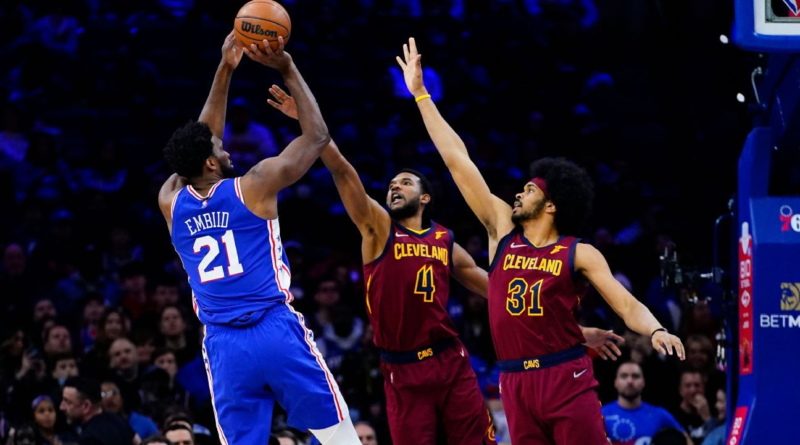'Teams are looking for a different type of big': The Cavaliers have two
EVAN MOBLEY CROUCHES his thin frame into a defensive stance on the perimeter, a place few 7-footers have ever been as comfortable as the Cleveland Cavaliers‘ 21-year-old franchise cornerstone.
It’s midway through the first quarter of the Cavs’ season opener, and on this play, Toronto Raptors forward Pascal Siakam gets a step on Mobley while driving the middle of the lane.
But Mobley has a luxury few NBA teams possess: help in the form of another 7-footer, All-Star center Jarrett Allen.
Allen slides over, leaving Toronto’s Scottie Barnes alone on the baseline and positioning himself to contest Siakam in the restricted area. Siakam dishes to Barnes under the basket for what would typically be an easy finish, but such buckets are few and far between when the Cavaliers’ 7-footers share the floor. Mobley helps his helper, leaping to block Barnes’ layup.
“We have each other’s back,” Allen says. “That’s the advantage of having two 7-footers. If you blow by the first one, there’s a second one for you.”
It’s a moment that illustrates one of the primary benefits of playing big — provided that the tall personnel are also agile and instinctive — in a league that increasingly relies on small ball, positionless lineups and outside shooting.
“I know we’re all enamored with the 3,” Cavaliers coach J.B. Bickerstaff says, “but to win in this league, you’ve got to win the paint, and that’s both ends of the floor. If you have big guys, it’s just easier to do that.”
While the Cavaliers aren’t alone in bucking the leaguewide small-ball trend — the Minnesota Timberwolves have paired All-Stars Karl-Anthony Towns and Rudy Gobert this season with mixed results, and other teams have put their own spins on dual-big lineups — Cleveland might have set the standard.
“Size and skill,” Bickerstaff says, “will beat small and skill every day.”
“POWER FORWARD” HAS become an outdated term, as teams typically prioritize shooting, skill and defensive versatility at that position as opposed to the bruising post-up threats from past generations.
However, as Bickerstaff points out, the previous few NBA Finals are proof that size in the frontcourt still matters in today’s NBA:
-
The Los Angeles Lakers won the 2020 title in the bubble with Anthony Davis starting alongside Dwight Howard, although they did shift to a smaller lineup with Davis at center for the closeout win against the Miami Heat.
-
The Milwaukee Bucks played big during their 2021 championship run with Brook Lopez and Giannis Antetokounmpo as a dominant defensive duo, but Antetokounmpo’s ability to create offensively shatters the power forward prototype.
-
The Boston Celtics‘ big tandem of Al Horford and Robert Williams III formed a firm defensive backbone during the Celtics’ march to the Finals last season, a partnership put on hold this season while Williams recovers from offseason knee surgery. While Williams fits into the “traditional modern big” category — that’s a term Allen came up with to describe centers like himself whose primary offensive contributions are screening, finishing and rebounding — Horford’s capable passing and 3-point shooting complement stars Jayson Tatum and Jaylen Brown.
-
The Memphis Grizzlies have emerged as a Western Conference contender with Jaren Jackson Jr., an All-Defensive shot-blocker with perimeter offensive skills, starting next to bruising center Steven Adams, although Adams was benched in the first round last season because of struggles defending Towns.
-
The rebuilding Orlando Magic have created intrigue with their supersized starting lineup that features Bol Bol, who has shooting guard skills in a skinny, 7-foot-2 frame, starting between two muscular 6-foot-10 teammates, Rookie of the Year contender Paolo Banchero at forward and center Wendell Carter Jr.
The Cavaliers, for their part, didn’t necessarily center their game plan on going big. But the pieces fell in place for a franchise that was in Year 3 of a rebuild following four straight LeBron James-led trips to the Finals.
When he was the team’s general manager, Cleveland president of basketball operations Koby Altman wiggled into the multiteam deal that sent James Harden from the Houston Rockets to the Brooklyn Nets at the 2021 trade deadline, parting with the Bucks’ 2022 first-round pick to acquire Allen from Brooklyn. The Cavaliers considered it a bargain for a young center they anticipated would anchor their starting five for the foreseeable future, so much so that they locked up Allen to a five-year, $100 million deal that summer.
The Cavaliers had the No. 3 overall pick in the draft months later and considered Mobley the best player in the 2021 class. They didn’t hesitate when Mobley was still on the board.
“We thought that Evan was a franchise-changing player,” Bickerstaff says. “When you have an opportunity to get a cornerstone, you don’t pass that up because of what you think of position.”
The Cavaliers’ front office and coaching staff believed Mobley’s passing and ballhandling ability would mesh with Allen’s skills. They were certain the duo would thrive defensively, due to their size and ability to defend multiple positions.
“When you start to think about long-term success and you start to think about the playoffs, how many times do you see big guys get played off the floor?” Bickerstaff says. “They can’t switch, they can’t guard pick-and-roll, so now they’ve got to go sit down and they can’t play.
“We were extremely fortunate to look at those two guys, and they have the ability to do that.”
“The game has changed. Everything a big man does has evolved into something different. Teams are looking for a different type of big who can guard 1 through 5. Like us.”
Cavs center Jarrett Allen
The Cavaliers vaulted from 25th to fifth in defensive efficiency during Mobley’s rookie season, escaping a three-year stretch near the Eastern Conference cellar to win 44 games and qualify for the play-in tournament. Cleveland, which drastically upgraded its offense by trading for All-Star guard Donovan Mitchell this past summer, has the fourth-ranked defense and a 13-8 record heading into Wednesday’s 7 p.m. ET game against the visiting Philadelphia 76ers.
“You’ve seen the evolution of the big man,” Allen says. “The game has changed. Everything a big man does has evolved into something different. Teams are looking for a different type of big who can guard 1 through 5.
“Like us.”
The presence of a pair of 7-footers capable of protecting the rim and comfortably switching onto perimeter scoring threats provided a level of security that allowed the Cavaliers to continue to excel defensively even after Mitchell joined fellow undersized All-Star Darius Garland in the backcourt.
“You go get Donovan no matter what if you’re able to go and get him, but having them there as a security blanket, obviously that’s a plus,” Bickerstaff says.
“Our two big guys are elite defensively. They’re not like OK or run-of-the-mill bigs. They are elite big guys, so it was our mindset that no matter who you put in front of them, they were going to be able to do the job and protect whoever is there.”
ULTIMATELY, CLEVELAND’S CEILING could be determined by Mobley’s development as a scorer. He is averaging 15.0 points this season, the same as his rookie campaign but on improved efficiency, and the Cavaliers believe Mobley will grow into a potent scorer.
“It’s crazy — and I don’t mean this in a bad way — but I don’t think he really understands how good he can be,” Mitchell, the 26-year-old elder statesman among Cleveland’s four foundational players, says of Mobley, 21. “He can be really special, and he can take us to a completely different level. I personally believe he can be a top-five player in this league.”
The hope for Mobley is that he can develop into a more dynamic version of Horford and make opponents respect him as a 3-point threat.
“We’re not asking him to have everything today,” Mitchell says. “We’re going to grow as a group through the years. I don’t even think we’ve scratched the surface, to be honest.”
Mobley hasn’t yet proved that the 3-point shot is a part of his arsenal, creating spacing challenges for a team that features premier creators in Mitchell and Garland, 22. If Mobley becomes even an average 3-point shooter, particularly from the corners, Cleveland’s explosive guards would have significantly more room to operate on isolations and pick-and-rolls with Allen, 24, an elite lob threat who has good touch around the basket. Defenders feeling the need to close out hard against him could unlock more of Mobley’s ability to make plays off the dribble, too.
“That’s where the league is going,” Mobley says. “I feel pretty good with it so far. I haven’t shot a lot this year, but I think it’s just going to grow from here and keep getting better.”
Mobley is shooting only 21.1% from 3-point range on less than an attempt per game, a reduction in volume from his rookie season. The work Mobley puts in at the Cavaliers’ practice facility, where he will often make 8 of 10 attempts from seven different spots around the arc, has yet to translate to games.
“He still has so much room to grow, so much more things he can expand in his game,” Allen says. “He’s shown excellent flashes of what he can do. Everybody dreams of a stretch big. With Evan, it’d be a stretch big that can be one of the best defensive players in the league.”





